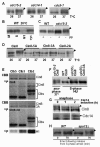Phospho-regulation of kinesin-5 during anaphase spindle elongation
- PMID: 21378308
- PMCID: PMC3048887
- DOI: 10.1242/jcs.077396
Phospho-regulation of kinesin-5 during anaphase spindle elongation
Abstract
The kinesin-5 Saccharomyces cerevisiae homologue Cin8 is shown here to be differentially phosphorylated during late anaphase at Cdk1-specific sites located in its motor domain. Wild-type Cin8 binds to the early-anaphase spindles and detaches from the spindles at late anaphase, whereas the phosphorylation-deficient Cin8-3A mutant protein remains attached to a larger region of the spindle and spindle poles for prolonged periods. This localization of Cin8-3A causes faster spindle elongation and longer anaphase spindles, which have aberrant morphology. By contrast, the phospho-mimic Cin8-3D mutant exhibits reduced binding to the spindles. In the absence of the kinesin-5 homologue Kip1, cells expressing Cin8-3D exhibit spindle assembly defects and are not viable at 37°C as a result of spindle collapse. We propose that dephosphorylation of Cin8 promotes its binding to the spindle microtubules before the onset of anaphase. In mid to late anaphase, phosphorylation of Cin8 causes its detachment from the spindles, which reduces the spindle elongation rate and aids in maintaining spindle morphology.
Figures



References
-
- Blangy A., Lane H. A., d'Herin P., Harper M., Kress M., Nigg E. A. (1995). Phosphorylation by p34cdc2 regulates spindle association of human Eg5, a kinesin-related motor essential for bipolar spindle formation in vivo. Cell 83, 1159-1169 - PubMed
Publication types
MeSH terms
Substances
Grants and funding
LinkOut - more resources
Full Text Sources
Molecular Biology Databases
Miscellaneous

